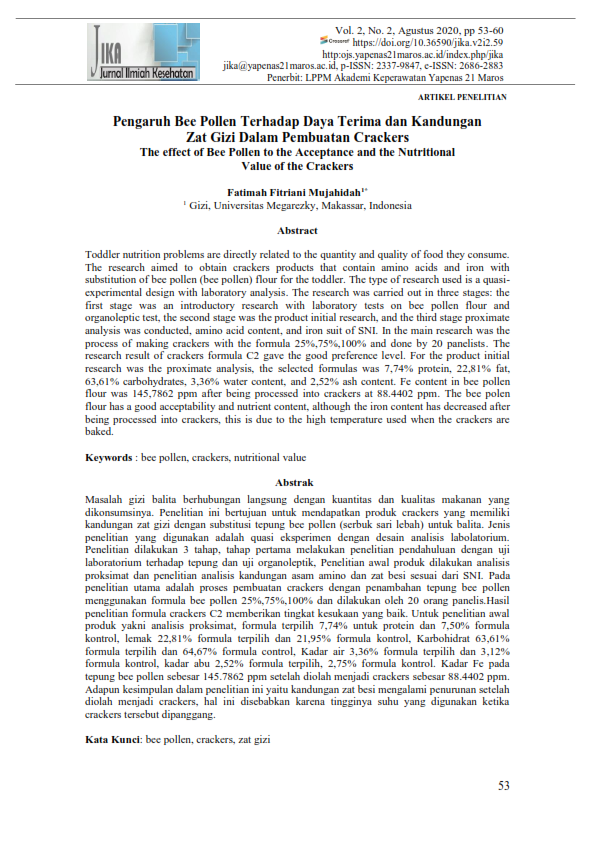The effect of Bee Pollen to the Acceptance and the Nutritional Value of the Crackers
DOI:
https://doi.org/10.36590/jika.v2i2.59Keywords:
bee pollen, crackers, nutritional valueAbstract
Toddler nutrition problems are directly related to the quantity and quality of food they consume. The research aimed to obtain crackers products that contain amino acids and iron with substitution of bee pollen (bee pollen) flour for the toddler. The type of research used is a quasi-experimental design with laboratory analysis. The research was carried out in three stages: the first stage was an introductory research with laboratory tests on bee pollen flour and organoleptic test, the second stage was the product initial research, and the third stage proximate analysis was conducted, amino acid content, and iron suit of SNI. In the main research was the process of making crackers with the formula 25%,75%,100% and done by 20 panelists. The research result of crackers formula C2 gave the good preference level. For the product initial research was the proximate analysis, the selected formulas was 7,74% protein, 22,81% fat, 63,61% carbohydrates, 3,36% water content, and 2,52% ash content. Fe content in bee pollen flour was 145,7862 ppm after being processed into crackers at 88.4402 ppm. The bee polen flour has a good acceptability and nutrient content, although the iron content has decreased after being processed into crackers, this is due to the high temperature used when the crackers are baked.
Downloads
References
Attia YA, Abd Al-hamid AE, Ibrahim MS, Al-Harthi MA, Bovera F, Elnaggar AS. 2014. Productive performance, biochemical and hematological traits of broiler chickens supplemented with propolis, bee pollen, and mannan oligosaccha- rides continuously or intermittently. Livest Sci 164: 87-95.
Burke R, Juan S, Parminder S. 2014. Identification, prevention and treatment of iron deficiency during the first 1000 days. Journal Nutrients. 6: 4093-4114.
[BSN] Badan Standardisasi Nasional. 2011. SNI standar mutu cookies (SNI: No 012973-1992).
Dewan Ketahanan Pangan. 2009. Peta ketahanan dan kerentangan pangan Indonesia. Jakarta
Estevinho LM, Rodrigues S, Pereira AP, Feás X. 2012. Portugese bee pollen: palynologycal study, nutritional and microbiological evaluation. Int J Food Sci Tech. 47: 429-435.
Febrianto NA, 2014. Kajian karakteristik fisikokimia dan sensoris tortila corn chips dengan variai larutan alkali pada proses nikstamalisasi jagung. Jurusan Ilmu dan Teknologi Pangan, Fakultas Pertanian: Universitas Sebelas Maret Surakarta.
Ghassemi A, Keikhaei B. 2014. Effects of nutritional variables in children with iron deficiency anemia. International Journal of Pediatric. 2(7): 183-187.
Harzau, Estiasih. 2013. Karakteristik cookies umbi inferior uwi putih (kajian proporsi tepung uwi : patu jagung dan penambahan margarin). Jurnal Pangan dan Agroindustri. 1(1) : 138-147
Jain, M. 2013. Combinating iron deficiency anemia through food to food fortification: recipe developmen, iron bioavailability and effect of supplementation. IJFANS. 2320-7876.
Kemenkes RI. 2013. Riset Kesehatan Dasar. http://www.depkes.go.id.
Kustyawati ME, Susilawati, Tobing D, Trimaryanto. 2012. Profil asam lemak dan asam amino susu kambing segar dan terfermentasi. J Teknol Industri Pangan 23: 47-52.
Nopiana. 2013. Pengaruh pemberian ekstrak etanol 70% daun kelor (Moringa oleifera Lamk.) terhadap tekanan darah tikus putih betina anemia. Depok (Indonesia): Universitas Indonesia.
[WHO] World Health Organization. 2013. Micronutrient Deficiency. USA: World Health Organization
Prieto-patron, , Hutton Zsuzsa V, Garg Pankaj, Shashidhar Rao, Alison L Eldridge, Patrick Detzel. 2017. The association between complementary foods and hemoglobin concentrations in indian infants. Journal of human nutrition and food science. 5:1–11.
Proverawati A, Wati EK. 2011. Ilmu gizi untuk keperawatan dan gizi kesehatan. Yogyakarta: Nuha Medika.
Sandjaja S, Budiman B, Harahap H, Ernawati F, Soekatri M, Widodo Y, Sumedi E, Rustan F, Sofia G, Syarief SN, Khouw I. 2013. Food consumption and nutritional and biochemical status of 0.5-12-year-old Indonesian children: the SEANUTS study. British J Nutr. 110: 11-20.
Suarti B, AS Ardyanto, MDB Masyhura, MM Evan Ardyanto AS. 2015. Penambahan tepung daun kelor dan lama pemanggangang terhadap mutu biskuit dari mocaf (Modified Cassava Flour). Jurnal UMSU. 19(3):238–48.
Subandoro RH, Basito dan Atmaka W. 2013. Pemanfaatan tepung millet kuning dan tepung ubi jalar kuning sebagai subtitusi tepung terigu dalam pembuatan cookies terhadap karakteristik organoleptik dan fisikokimia. Jurnal teknosains pangan. 2 (4).
Rahmawati, Wahyuni Fitri, Widyastuti HN. The effect of oyster mushrooms flour substitution to the acceptance and nutrient content of dried noodles. Jurnal Dunia Gizi. 1(2): 119-126.
Utiarahman G, Harmain RM, Yusuf N. 2013. Karakteristik kimia dan organoleptik nugget ikan layang yang disubtitusikan dengan tepung ubi jalar putih. jurnal penelitian. Fakultas Ilmu Pertanian. Universitas Negeri Gorontalo. Gorontalo.
Winarno FG. 2008. Kimia pangan dan gizi. Jakarta: PT Gramedia Pustaka Umum.
Yang K, Wu D, Ye X, Liu D, Chen J, Sun P. 2013. Characterization of chemical composition of bee pollen in China. J Agric Food Chem. 61: 708-718.









